This page was last modified on October 29, 2024
PSY 355 Psychology & Media in the
Digital Age
This page was last modified on October 29, 2024 |
Class 20: The Wonderful World of The Walt Disney Company • Part 2 • Creating A National Mythology: Princesses & Talking Animals
Characteristics of the Classic Disney Model (from Wasko, 2020, pp. 233-243, Box 5.1)
From the beginning of the company's development as a producer of media (films, animations cartoons) and in its earlier decades (1923-1960s), there were consistent elements which comprise what scholars have called the "Classic Disney" model
Style
Story
- light entertainment
- music
- humor (often physical gags & slapstick)
- often revised versions of traditional fairy tales or folklore
- uses the classic Hollywood cinema model, that is
- the story is set mostly in the present (with some occasional memories, fantasies, dreams, and other mental states)
- individual characters have clear motives which are the cause of what happens in the story and its consequences
- the main characters succeed in reaching the goal (that is, happy endings), the film comes to a close without unresolved plot lines
- clear causes and effects of actions
- the editing and other film-making technique assure that the story follows a clear and linear development
Characters
Themes/Values
- animal characters who are anthropomorphized (made to be human-like) and neotenized (adult characters showing childlike behaviors)
- formulaic heroines, heroes, villains, and sidekicks
- stereotypical representations of gender and ethnicity
- mainstream American values
- individualism
- work ethic
- optimism
- escape, fantasy, magic, imagination
- innocence
- romance & happiness
- good wins over evil
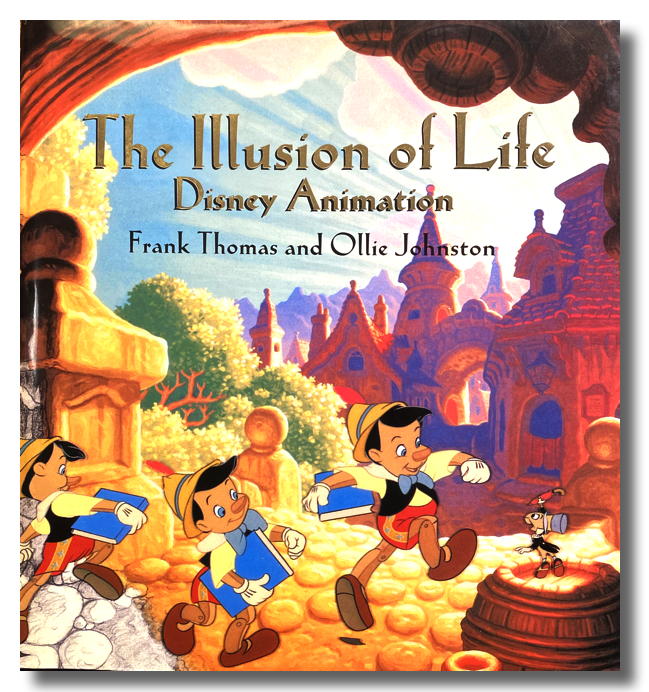
In small groups of 3 or 4 persons, accomplish the following:
- Each person should come up with the favorite or two favorite Disney characters
- For each character, discuss
- What is/are their most important physical trait(s)?
- What is/are their most important personality trait(s)?
- Is/are their other aspects to the character that appeal to you?
- When you have done this for each group member, find out if there are any commonalities or similar character traits that arose?
Whole Class
- Each group should share a summary of their discussion
- Questions/Issues for the entire class
- Gender
- Ethnicity
- Age
- Spirituality/belief system
- What kind of world do these characters emerge from?
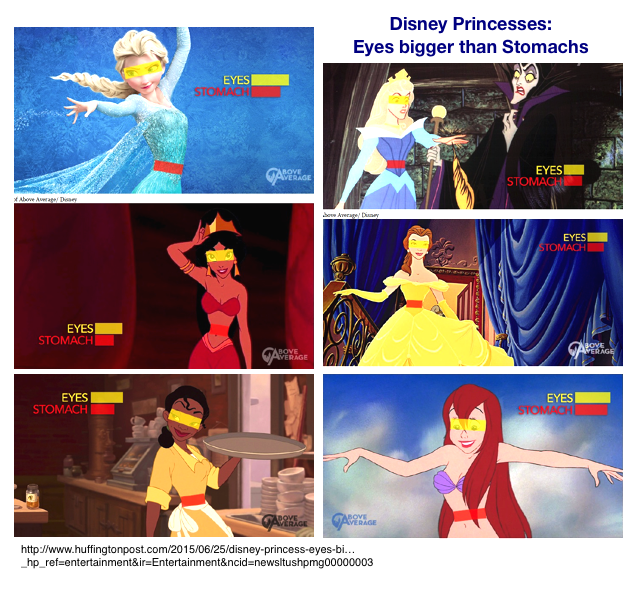 The
"Princess" role (England et al., 2011)
The
"Princess" role (England et al., 2011)
- The actual selling of "Princess" merchandise by Disney Consumer Products began in 2000
- Originally 9 (now 13 with Raya [Raya and the Last Dragon, 2021]) films, 26,000 products
- Forbes business magazine reported that, in 2012, Disney-licensed Princess products generated $1.6 billion in the US and $3 billion globally. Note, too, that other Disney-licensed products also included Star Wars ($1.5 billion), Pooh ($1.09 billion), Cars ($1.05 billion), Mickey & Friends ($750 million), and Toy Story ($685 million), that is, over $8 billion in retail sales.
- Rules for Disney Princesses
- Must be the featured role in a Disney or Pixar film
- Must be royal by birth, or marriage, or do a heroic deed (e.g., Mulan)
- Must be human or human-looking (e.g., Ariel in Little Mermaid)
- Must be recognizable and appealing to audience
- Must be "beautiful" outside and inside
- Usually have an animal sidekick and are innately skilled at communicating with animals
- Usually are gifted singers
- Film must not be a flop or a major hit
- Note, BTW, whenever the Disney Princesses are shown in a group, none of them look at each other or acknowledge each others' presence. Each is staring at something in the distance, but none are looking at the same thing. This is deliberate. It is meant to preserve the "individual mythology" of each princess.
Male stereotypical characteristics: Curious about princess, exploring, physically strong, assertive, unemotional, independent, athletic, engaged in intellectual activity, inspires fear, brave, physically attractive, gives advice, leader, rescuing
Feminine stereotypical characteristics: Pays attention to physical appearance, physically weak, submissive, shows emotion, affectionate, nurturing, sensitive, tentative, helpful, troublesome, fearful, ashamed, collapses crying, physically attractive, asks for advice, victim
Disney princes vs. Disney princesses
Prince tends to be
- High in showing emotions, affectionate, physically strong, assertive, athletic
- Low in paying attention to appearance of others, being ashamed, crying
Princess tends to be
- High in affectionate, fearful, troublesome, athletic, assertive (esp. toward animals)
- Low in being unemotional, leadership, inspiring fear, performing a rescue
Physical attractiveness and Body Shapes (Rutherford & Baker, 2021)
Body Modification/Metamorphosis/Shape-shifting
- 1937 Snow White: Queen becomes the witch
- 1959 Sleeping Beauty: “bad” Maleficent become a malevolent (wishing to do evil) dragon
“Princess Bubble” - Narrow range of acceptable physical appearance for princesses
- To win the heart of a prince, the princess must be flawlessly beautiful (especially compared to less attractive rivals including sisters and other family members)
- 9 princesses are white skinned; Jasmine’s skin tone has been lightened over time; Tiana is now tanned rather than the original dark African American complexion of 2009
- Most princesses have blue eyes; all have large and bulbous eyes with large irises & pupils, very long hair, and extremely long eyelashes giving a child-like look of innocence.
- Slim bodies are disproportionate with long necks, medium to large-sized breasts but tiny waists, wrists, ankles, and feet
- “Love at first sight” often predominates in which a prince falls in love because of physical beauty and before the princess has even spoken a word (or, in Sleeping Beauty, only overhears Aurora singing)
The Beauty = Goodness Stereotype (Bazzini et al. 2010)
Heroes
“Magic Mirror on the wall, who is the fairest one of all?” – this famous question from the classic fairy tale Snow White is first posed by Disney’s Evil Queen in the 1937 feature film Snow White and the Seven Dwarves. The wicked woman is jealous of her stepdaughter for being the most beautiful woman in the land. Ever since, she has asked her question again and again on the TVs of children and adults alike due to dozens of re-releases of DVD’s, the ever-present and ongoing popularity of Disney films, its merchandise, and Disney’s dominant cultural role in societies all over the world.In 1989, the wicked sea witch Ursula tells the little mermaid Ariel, that, in order to impress her love interest, she should not “underestimate the importance of body language” and rely on her “looks” and “pretty face.” In 1991, Belle, “the most beautiful girl in town” from Beauty and the Beast, has to teach a prince who was turned into a hideous, aggressive beast due to his unkind personality that “beauty is found within” – however, as soon as she successfully did so, the monster changes back into a handsome prince and his now appealing character is visualized through his appealing looks. The common denominator of all these examples is their emphasis on and importance of physical appearance and beauty . In Disney movies, where a clear distinction between good and evil, morality and immorality, is represented, a beautiful appearance tends to be equated with a kind personality and is thus assigned to heroes and heroines, whereas villains are largely portrayed as undesirable and repulsive. These visual representations are highly idealized and exaggerated and resonate with common ideals of beauty which are dominant during the times the films are produced." (Buchegger, 2020, references omitted)
Five Worlds of the Imagination
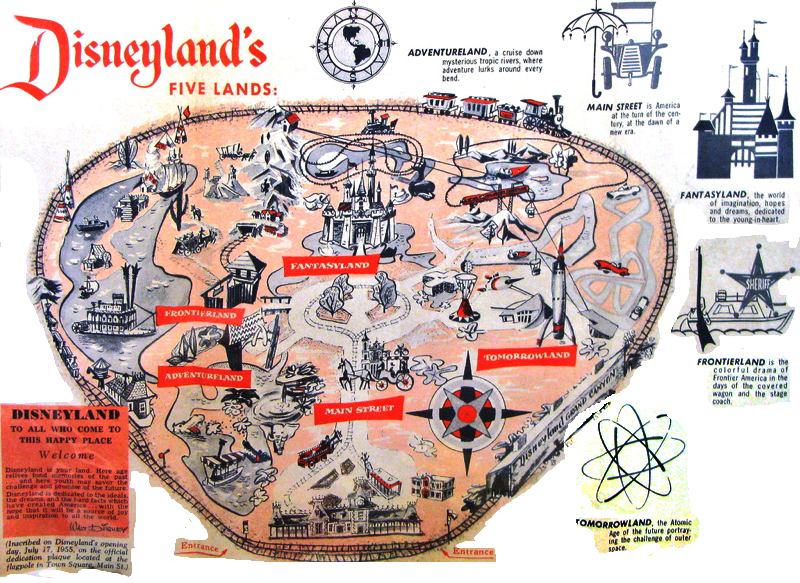
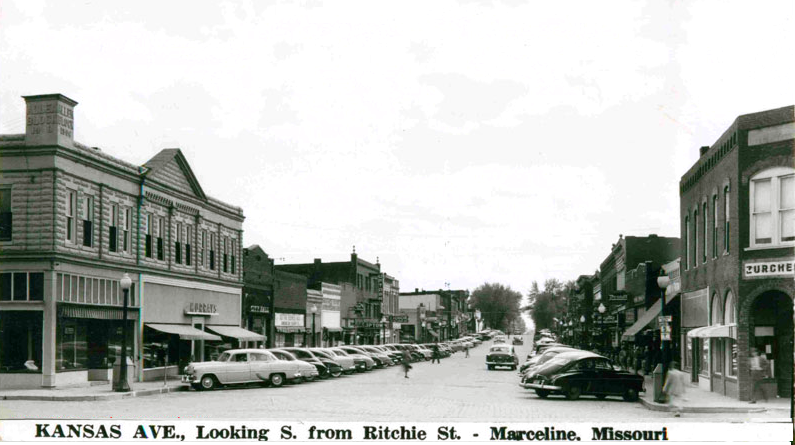
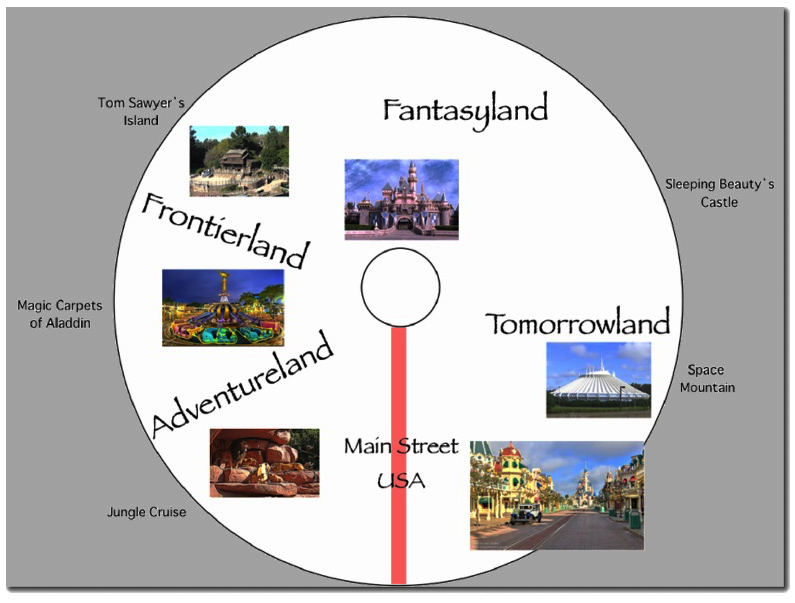
Characteristics of Disney Theme Parks (Wasko, 2020, pp. 342-360)
Synergy
- parks bring together characters, stories, and merchandizing in one spot
- new park elements (e.g., the Pirates of the Caribbean ride) can inspire films (https://en.wikipedia.org/wiki/Pirates_of_the_Caribbean_(attraction))
Consumption/Commodification (= turning something into a item that can be bought and sold)
- experiencing the park involves buying packages and the selling of experiences and memories
Commercialization/corporatism
- pathways of park always lead toward shops where merchandise can be bought or to photo kiosks to create memories
“Going to Disneyland” as a Family Experience
- Disney creates strategic alliances with other corporations (e.g., in EPCOT with AT&T, Coca-Cola, General Motors, etc. or the Carousel of Progress once sponsored by General Electric)
“Backstage Magic”
- Families make a kind of “pilgrimage” to Disney parks which serve almost like a contemporary "sacred center"
- Parents feel compelled to visit with their children and participate in various rituals in the park.
- The parks display extraordinary creations of the Disney Imagineers which evoke admiration by viewers
Predictability & expectations
- The parks themselves are extraordinarily clean, efficient, and organized using state of the art technology
- Parks offer predictatable experiences which are safe and reliable.
Control, control, control
- Visitors expect to have happy times in the park with the “cast members” always polite, courteous, and never out of character.
- The park is laid out in ways to control visitor activities and experiences beginning with Main Street USA
- Attractions and rides are “programmed” with prearranged views and carefully planned sounds/movements. Everyone sees the same thing.
Control as a theme or motif
- Controlled imagination in which visitors experience the park’s attractions in a fairly passive fashion; relatively few opportunities to play or act spontaneously.
- Visitors exposed to the notion that environments can be engineered.
- The “taming of the American West” in Frontierland
- The ability to subjugate and control the rest of the world in Adventureland
References
Bazzini, D., Curtin, L., Joslin, S., Regan, S., & Martz, D. (2010). Do animated Disney characters portray and promote the beauty-goodness stereotype? Journal of Applied Social Psychology, 40(10), 2687-2809.
Buchegger, L. (2020). ”The fairest one of all": Appearance and body images in Disney's feature films. Master’s thesis. Germany: Karl-Franzens-Universität Graz, Institut für Amerikanistik.
England, D. E., Descartes, L., & Collier-Meek, M. A. (2011). Gender role portrayal and the Disney princess. Sex Roles, 64, 555-567.
Rutherford, A., & Baker, S. (2021). The Disney ‘Princess Bubble’ as a Cultural Influencer. M/C Journal, 24(1). https://doi.org/10.5204/mcj.2742 (Original work published March 13, 2021)
Stark, S. D. (1997). Glued to the set. New York: Delta Books.
Wasko, J. (2020). Understanding Disney: The manufacture of fantasy (2nd ed.). New York: John Wiley & So